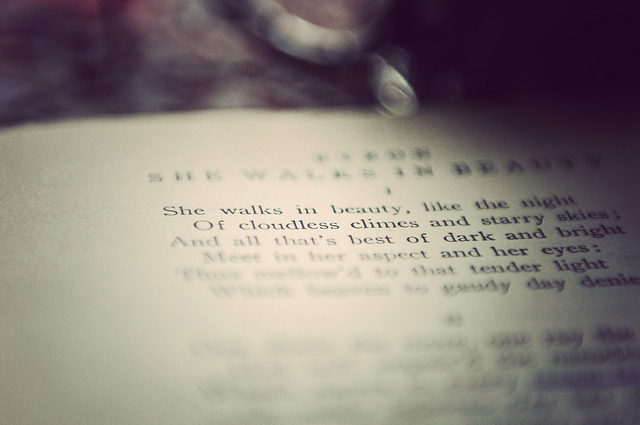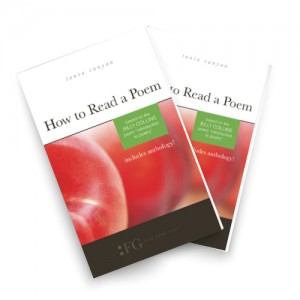
The poems that endure, endure for a reason, but I usually can’t say why. For every beautiful, cutting, or mysteriously gripping poem you read to me, I can read you a dozen more. But some of them have, I don’t know. . .a nameless grace? One image the more, one line the less, and the poem becomes impaired, impure, a little less lit by stars.
Dissection can surely uncover the technical workings of a poem’s anatomy. And while there is nothing inherently wrong with dismembering a poem in the name of literary investigation–it can be disturbingly fun, in fact– you won’t find its soul that way. You can memorize your lover’s every hair, freckle, and laugh line with a series of photographs, but until you spend time with him, you will never really know him or her.
On my quest to experience some classic poems afresh, I decided to first take up “She Walks in Beauty” by Lord Byron. Of course I’ve heard it countless times. In a way, that’s the biggest challenge with the classics. We hear them so much, we stop listening.
So my goal was to listen. Really, really, listen. First I read the poem aloud about ten times. Then, for an entire morning and afternoon, I read it aloud on the hour, sometimes every half hour, and just let it work its way in. Different words and images hit me at different times. Sometimes I lingered over “cloudless climes and starry skies,” placing myself in the night. Sometimes I got tangled in the “raven tresses.” I read it quickly, I read it slowly. I read it loudly and quietly. I read it while making coffee, stir-frying zucchini, walking upstairs with laundry, and, well, going to that other room where people tend to read.
What did I discover?
This is where I need to be careful. As tempting as it was to consult the “outside,” I refrained from reading commentaries or talking to professor friends while spending the day with this poem. Likewise, I wouldn’t want this post to color your date with “She Walks in Beauty” too much. But here are a few questions I began to ask myself while reading:
● What is the best of dark and light in this poem? With “she?” With a person I know?
● How do the rhyme and rhythm of the poem help me “walk” with her? How does it feel to walk with her?
● “One shade the more, one ray the less.” What or whom do I have these kinds of feelings for? Why?
● What kind of beauty do I see in this poem? What does beauty mean here? With someone important to me?
Of course I’m not finished. That is why the poem endures.
What about you? Go ahead. Read it aloud. Once, twice, on the hour. Try to name what is nameless, which, I believe, is the greatest reward of reading poetry.
She walks in beauty, like the night
Of cloudless climes and starry skies;
And all that’s best of dark and bright
Meet in her aspect and her eyes;
Thus mellowed to that tender light
Which heaven to gaudy day denies.
One shade the more, one ray the less,
Had half impaired the nameless grace
Which waves in every raven tress,
Or softly lightens o’er her face;
Where thoughts serenely sweet express,
How pure, how dear their dwelling-place.
And on that cheek, and o’er that brow,
So soft, so calm, yet eloquent,
The smiles that win, the tints that glow,
But tell of days in goodness spent,
A mind at peace with all below,
A heart whose love is innocent!
—Lord Byron
Photo by Ashton, Creative Commons, via Flickr. Post by Tania Runyan, author of How to Read a Poem.
Get a free Coloring Page of Byron’s “She Walks in Beauty”
Read more classic poems, like The Sick Rose, by William Blake



